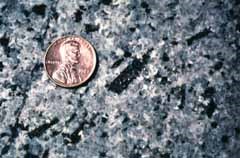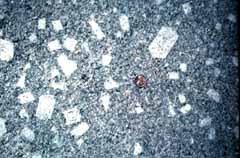The North America Wall Is Proof That Yosemite Granite Was Over and Over Again
On This Page Navigation
Yosemite is a glaciated landscape, and the scenery that resulted from the interaction of the glaciers and the underlying rocks was the basis for its preservation as a national park. Iconic landmarks such equally Yosemite Valley, Hetch Hetchy, Yosemite Falls, Vernal and Nevada Falls, Bridalveil Fall, Half Dome, the Clark Range, and the Cathedral Range are known throughout the world by the photographs of countless photographers, both amateur and professional. Landforms that are the result of glaciation include U-shaped canyons, jagged peaks, rounded domes, waterfalls, and moraines. Glacially-polished granite is farther evidence of glaciation, and is common in Yosemite National Park.
The Making of the Mural
Topographically, the Sierra Nevada is an asymmetric mountain range with a long, gentle west gradient and a curt, steep east escarpment that culminates in the crest of the Sierra Nevada. It is l to 80 miles wide and extends in altitude from near sea level forth its west edge to more than thirteen,000 feet along the crest in the Yosemite expanse, and more than than 14,000 feet along the crest in the Sequoia-Kings Canyon area. The highest pinnacle in the Sierra Nevada, and in the continental United States, can exist constitute to the south: Mount Whitney in Sequoia National Park. Geologically, the Sierra Nevada is a huge block of the Earth's chaff that has broken free on the east along a bounding fault organization and has been uplifted and tilted westward. This combination of uplift and tilt, which is the underlying geologic process that created the present range, is nevertheless going on today.

Massive granite dominates the Yosemite expanse and much of the Sierra Nevada as well. Mountain Hoffmann and most of the terrain visible from it are composed of granite, formed deep within the Earth by solidification of formerly molten rock fabric and subsequently exposed by erosion of the overlying rocks. Because of its massiveness and immovability, granite is shaped into assuming forms: the cliffs of Yosemite and Hetch Hetchy Valleys, many of the higher peaks in the park, and the hitting sheeted domes that tin course only in massive, unlayered rock. Although granite dominates nearly the entire length of the Sierra, the granite is not monolithic. Instead, it is a blended of hundreds of smaller bodies of granitic stone that, as magma (molten material), intruded one another over a timespan of more than than 100 million years. This multiplicity of intrusions is one of the reasons why there are and then many varieties of granitic rock in Yosemite and the remainder of the Sierra. The differences are non always credible to the coincidental observer, but they are reflected in sometimes subtle differences in advent and in differences in response to weathering and erosion interim on the rocks.
Layered metamorphic rocks in the foothills at the west edge of the park and along the eastern margin in the top area are remnants of aboriginal sedimentary and volcanic rocks that were deformed and metamorphosed in part by the invading granitic intrusions. Other metamorphic rocks that once formed the roof beneath which the granitic rocks solidified were long agone eroded away to betrayal the granitic core of the range, and but small isolated remnants are left. Considering Yosemite is centered on this deeply dissected body of granite, metamorphic rocks are sparse; they occupy less than five pct of the surface area of the park.

Development of the landscape is as much a role of the geologic story as the rocks themselves, and Yosemite is a place where the dynamism of geologic processes is well displayed. By the end of Cretaceous time, about 65 1000000 years ago, subsequently the granitic cadre of the range had been exposed, the area had a low relief in comparison with the mountains of today. Then, virtually 25 meg years ago, this lowland area began to be uplifted and tilted toward the southwest, a construction that would eventually atomic number 82 to the present Sierra Nevada. Every bit the charge per unit and degree of southwest tilt increased, the gradients of streams flowing southwestward to California'due south Central Valley also increased, and the faster flowing streams cutting deeper and deeper canyons into the mount cake. Near 10 one thousand thousand years ago, from the Tuolumne River northward, these canyons were inundated and buried past volcanic lava flows and mudflows, and the streams were forced to brainstorm their downcutting anew, in many places shifting laterally to detect a new road to the Central Valley. The streams were equal to the task, even so, and the nowadays river courses and drainage patterns throughout the Sierra became well established.

As the world grew colder, kickoff about ii or 3 million years agone, the Sierra Nevada had risen loftier enough for glaciers and a mountain icefield to form periodically along the range crest. When extensive, the icefield covered much of the college Yosemite surface area and sent glaciers downward many of the valleys. Glacial ice quarried loose and transported vast volumes of rubble, and used it to help scour and modify the landscape. Much of this debris somewhen accumulated along the margins of the glaciers and in widely distributed, hummocky piles. The greatest bulk of this debris, notwithstanding, was flushed out of the Sierra to the Central Valley by streams swollen with meltwater formerly stored in the glaciers as ice and released as the glaciers melted abroad.
Although many of today'southward general landforms existed before modification by glacial action, some of them surely did not. Can y'all imagine the Yosemite mural with no lakes? Nigh all the innumerable natural lakes in the park are the effect of glacial activity. But even these lakes are transitory, doomed to be filled with sediment and become meadows; many lakes already have undergone this transformation. Yosemite Valley itself once independent a lake.
The geologic story of Yosemite National Park can be considered in two parts: (1) deposition and deformation of the metamorphic rocks and emplacement of the granitic rocks during the Paleozoic and Mesozoic; and (two) after uplift, erosion, and glaciation of the rocks during the Cenozoic to form today's mural.
Rocks
The vast majority of Yosemite is comprised of plutonic igneous rocks. Plutonic rock forms deep underground when molten rock cools and solidifies very slowly, allowing big crystals to form. In contrast, volcanic igneous rocks class at the surface when molten rock cools and solidifies quickly, resulting in small crystals. Granite, granodiorite, tonalite, quartz monzonite, and quartz monzodiorite are all forms of plutonic rock that are establish in Yosemite, and are loosely referred to as granitic rocks. Quartz diorite, diorite and gabbro are plutonic rocks found in Yosemite, merely are not technically considered to be granitic rocks. Plutonic rocks are primarily comprised of 5 minerals: quartz, potassium feldspar, plagioclase feldspar, biotite, and hornblende. Plutonic rocks, including granitic rocks, differ primarily in the relative proportions of quartz and feldspar, although texture is also an important consideration. The plutonic rocks were by and large formed during the Cretaceous period.

The different individual bodies of plutonic rocks in Yosemite were formed from repeated intrusions of magma into older host rocks beneath the surface of the World. These intrusions may accept taken place over a time period equally long every bit 130 million years. These plutonic rocks, formerly deep inside the Earth, are at present exposed at the surface, owing to deep erosion and removal of the formerly overlying rocks.
Volcanic igneous rocks are erupted onto the Earth'due south surface and cool and solidify much more quickly than plutonic igneous rocks. At that place are minor amounts of volcanic igneous rocks inside Yosemite and large amounts east of the Sierra Nevada Crest. The volcanic rocks within the park include basalt flows, latite tuff, and latite lava flows. The volcanic rocks outside the park include these aforementioned rocks likewise every bit ash-flow tuff, rhyolite, pumice, obsidian, etc. The Mono Craters, east and southeast of the park, are volcanoes that erupted iii,000 to 550 years before present. The Inyo Craters, southeast of the park, are volcanoes that erupted 40,000 to three,000 years before present.

Metamorphic rocks are sedimentary or volcanic rocks that have been changed, or "metamorphosed," due to the temperature, pressure, and shearing stress that can event from being buried in the Earth's crust. At that place are two northwest-trending belts of metamorphic rocks, 1 on each side of the batholith of plutonic rocks that is the core of the Sierra Nevada range - these belts existed before the creation of the batholith and its subsequent exposure. Metamorphic rocks of volcanic origin are called metavolcanic rocks, and metamorphic rocks of sedimentary origin are called metasedimentary rocks. (Huber, 1989)
Videos
-

Yosemite Nature Notes 10: Rock Fall
Since the glaciers retreated around 15,000 years ago, stone fall has been the major force of change in Yosemite Valley. Geologists work to understand this strength of nature in social club to protect the millions of visitors who come here each year.
- Duration:
- viii minutes, 30 seconds
-

Yosemite Nature Notes 12: Glaciers
Yosemite National Park is famous for its spectacular glacially carved landscape. Although glaciers have come and gone many times in the past, there are still two active glaciers nearly Yosemite'south highest peaks.
- Duration:
- viii minutes, 34 seconds
-

Yosemite Nature Notes xx: Granite
Many national parks were founded for their geology, and Yosemite is known throughout the world for its exceptional high cliffs and rounded domes. Visitors to the park, from hikers to rock climbers, experience a mural dominated by granite.
- Elapsing:
- vii minutes, eleven seconds
Source: https://www.nps.gov/yose/learn/nature/geology.htm
Post a Comment for "The North America Wall Is Proof That Yosemite Granite Was Over and Over Again"